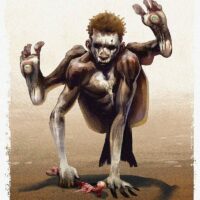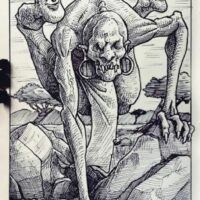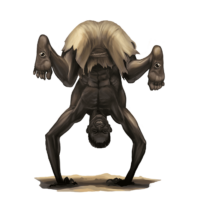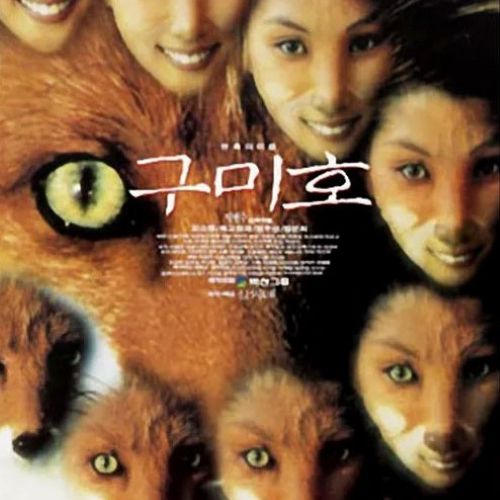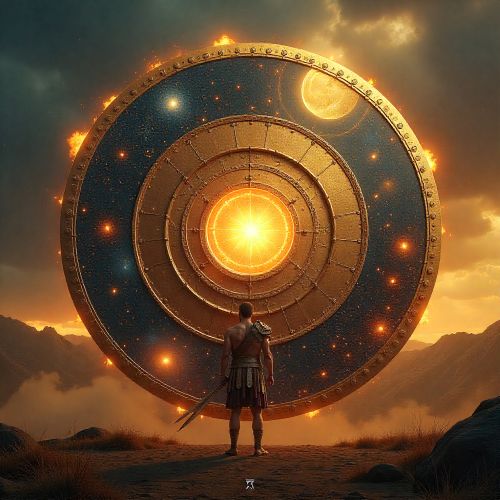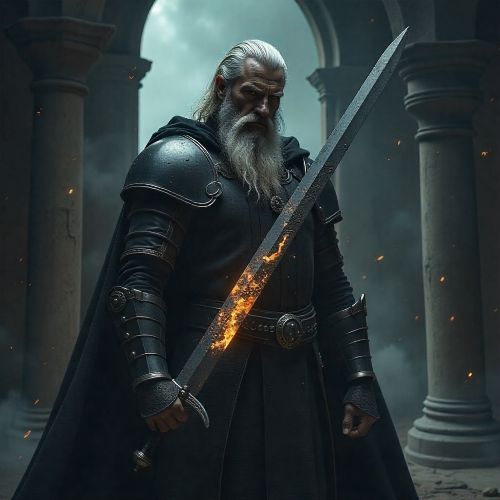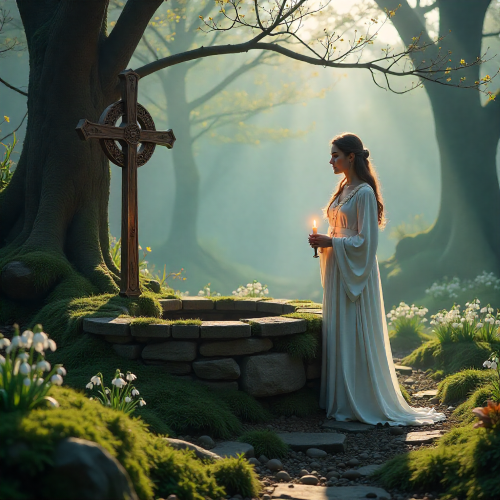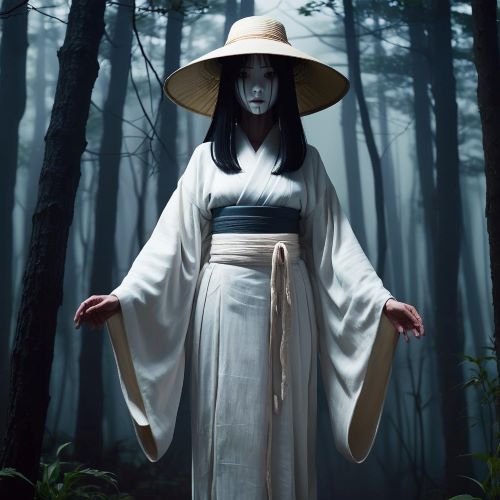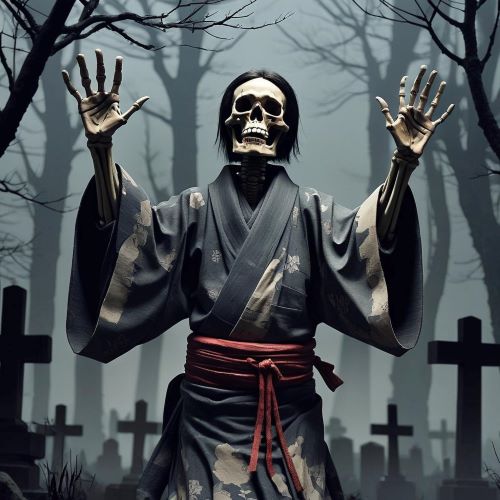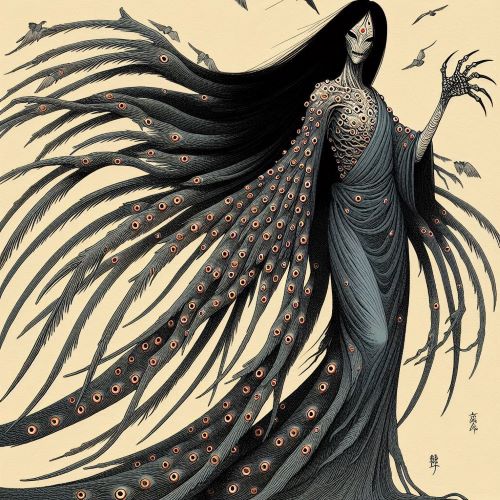Oiwa : The Vengeful Ghost
Listen
At a glance
| Description | |
|---|---|
| Origin | Japanese Mythology |
| Classification | Ghosts |
| Family Members | Iemon Tamiya (Husband) |
| Region | Japan |
| Associated With | Haunting, Possession |
Oiwa
Introduction
Oiwa is one of Japan’s most unforgettable ghost figures, embodying the archetype of the onryō, a vengeful spirit consumed by rage and sorrow. Her tale originates in the Edo-period kabuki play Yotsuya Kaidan (1825), written by Tsuruya Nanboku IV. The story is a haunting mix of betrayal, jealousy, and supernatural retribution, where Oiwa, wronged in life, returns in death to punish her treacherous husband and those who conspired against her. Unlike other Japanese yūrei, Oiwa is not simply a wandering ghost but a symbol of moral justice, representing the consequences of greed and disloyalty. Over time, she has grown from a kabuki creation into one of the Three Great Ghosts of Japan, alongside Okiku and Otsuyu, shaping the image of female spirits in Japanese culture and horror.
Physical Traits
Oiwa’s physical transformation is one of the most chilling aspects of her legend, setting her apart from other ghosts. In life, she was considered a loyal and devoted wife, but after being poisoned by her husband Iemon’s mistress, her beauty was destroyed. Her face became horribly disfigured—her eye sagged, her skin blistered, and her hair fell out in uneven clumps. This horrifying appearance became the visual embodiment of her anguish and betrayal.
Her ghostly form mirrors these features: pale, almost translucent skin, unkempt hair cascading over her face, and a white kimono, the traditional dress for the dead in Japanese funerary practice. In many depictions, Oiwa emerges from a paper lantern, symbolizing both her entrapment between worlds and her inevitable return to confront the living. This imagery is so powerful that it influenced the archetype of female ghosts in Japanese horror, from stage and ukiyo-e prints to modern cinema, where similar visual traits are used to invoke fear and recognition.
Family
The tragedy of Oiwa cannot be understood without her family connections. She was the daughter of Yotsuya Samon, who disapproved of her marriage to Iemon due to suspicions about his character. When Samon attempted to intervene, Iemon murdered him to secure his place in the family and keep Oiwa under his control. Oiwa’s fate was thus sealed by betrayal at the hands of both her husband and those around her who sought personal gain.
Her sister Osode also becomes entangled in Iemon’s treachery. Despite being promised to another, Osode became the object of Iemon’s desires, revealing his ruthless disregard for loyalty and honor. In some variations of the tale, Oiwa and Iemon also had a child, further intensifying the sense of injustice, as her death left the child vulnerable and fatherless. These family relationships highlight the theme of broken trust, showing how betrayal extended beyond Oiwa herself to the destruction of her entire household.
Other names
Although she is most commonly known as Oiwa, her presence is closely tied to the legacy of Yotsuya Kaidan, often referred to simply as “The Ghost Story of Yotsuya.” This association cements her role not just as a ghost but as the centerpiece of one of Japan’s most enduring horror narratives.
Another well-known name is Chōchin-Oiwa, or “Lantern Oiwa,” referencing the image of her ghost appearing from a paper lantern. Locally, she is sometimes called Oiwa-san or Oiwa-sama, titles that suggest a mix of respect and fear. Within Japanese folklore, Oiwa is also remembered as part of the Nihon San Dai Kaidan, the “Three Great Ghost Stories of Japan.” These alternate names reveal how Oiwa has transcended her kabuki origins to become a broader cultural symbol of betrayal, vengeance, and supernatural justice.
Powers and Abilities
As an onryō, Oiwa wields the ability to return from the spirit world, driven by a need to exact vengeance on those who wronged her. Unlike deities who command divine powers, her abilities are fueled by rage, sorrow, and betrayal. She is able to manipulate illusions, tormenting her victims by making them see her disfigured face in mirrors, shadows, and even in the faces of others. One of the most terrifying moments of her story comes when Iemon, on his wedding night, believes he is lifting the veil of his new bride, only to see Oiwa’s hideously scarred visage staring back at him.
Her presence is not limited to haunting a single place; she follows Iemon wherever he flees, her persistence serving as both a punishment and a reminder of his crimes. Beyond illusions, Oiwa brings misfortune, madness, and death to all who are complicit in her betrayal. Her powers symbolize the idea that wrongdoings in life cannot be escaped, and her spectral vengeance became a model for countless Japanese horror tales where ghosts torment rather than outright destroy.
Modern Day Influence
The story of Oiwa remains one of the most enduring ghost tales in Japan, and its influence can be seen across theater, film, literature, and even religious practices. Since its debut, Yotsuya Kaidan has been adapted into nearly three dozen films, making Oiwa one of the most frequently portrayed spirits in Japanese cinema. Directors such as Nobuo Nakagawa and Tai Katō brought her story to the screen, while more contemporary filmmakers, including Takashi Miike, reimagined her tale for modern audiences. These adaptations helped establish the conventions of Japanese horror, influencing global perceptions of yūrei.
Her ghostly image has also inspired iconic horror figures like Sadako from Ringu and Kayako from Ju-on, who share Oiwa’s pale skin, long black hair, and relentless pursuit of vengeance. Writers such as Junji Ito have drawn on her imagery to craft unsettling horror stories that blur the line between reality and nightmare.
Beyond the arts, Oiwa is honored in places like the Oiwa Inari Tamiya Shrine in Tokyo, where visitors pray for protection and offer apologies to avoid invoking her wrath. It has become common practice for film crews producing adaptations of Yotsuya Kaidan to visit her shrine, lighting candles and offering prayers before filming, in hopes of warding off misfortune. This blending of superstition and respect demonstrates the deep cultural impact Oiwa continues to hold.
Her story, though centuries old, remains a timeless reminder of the consequences of betrayal and the lingering presence of injustice. By transcending the kabuki stage to influence horror cinema, literature, manga, and even spiritual practices, Oiwa has secured her place as not only a central figure in Japanese folklore but also as an enduring archetype of the vengeful ghost.
Related Images
Source
Foster, M. D. (2009). Pandemonium and Parade: Japanese Monsters and the Culture of Yōkai. University of California Press.
Iwasaka, M., & Toelken, B. (1994). Ghosts and the Japanese: Cultural Experience in Japanese Death Legends. Utah State University Press.
Komatsu, K. (1999). Yōkai Gadan. Kōdansha.
Reider, N. T. (2010). Japanese Demon Lore: Oni from Ancient Times to the Present. Utah State University Press.
Yotsuya Kaidan. (n.d.). In Kabuki21.com. Retrieved August 26, 2025, from https://www.kabuki21.com/yotsuya_kaidan.php
Oiwa Inari Tamiya Shrine. (n.d.). Retrieved August 26, 2025, from https://www.japan.travel/en/spot/2030/
McRoy, J. (2008). Nightmare Japan: Contemporary Japanese Horror Cinema. Rodopi.
Frequently Asked Questions
What is lorem Ipsum?
I am text block. Click edit button to change this text. Lorem ipsum dolor sit amet, consectetur adipiscing elit. Ut elit tellus, luctus nec ullamcorper mattis, pulvinar dapibus leo.
What is lorem Ipsum?
I am text block. Click edit button to change this text. Lorem ipsum dolor sit amet, consectetur adipiscing elit. Ut elit tellus, luctus nec ullamcorper mattis, pulvinar dapibus leo.
What is lorem Ipsum?
I am text block. Click edit button to change this text. Lorem ipsum dolor sit amet, consectetur adipiscing elit. Ut elit tellus, luctus nec ullamcorper mattis, pulvinar dapibus leo.
What is lorem Ipsum?
I am text block. Click edit button to change this text. Lorem ipsum dolor sit amet, consectetur adipiscing elit. Ut elit tellus, luctus nec ullamcorper mattis, pulvinar dapibus leo.
What is lorem Ipsum?
I am text block. Click edit button to change this text. Lorem ipsum dolor sit amet, consectetur adipiscing elit. Ut elit tellus, luctus nec ullamcorper mattis, pulvinar dapibus leo.



